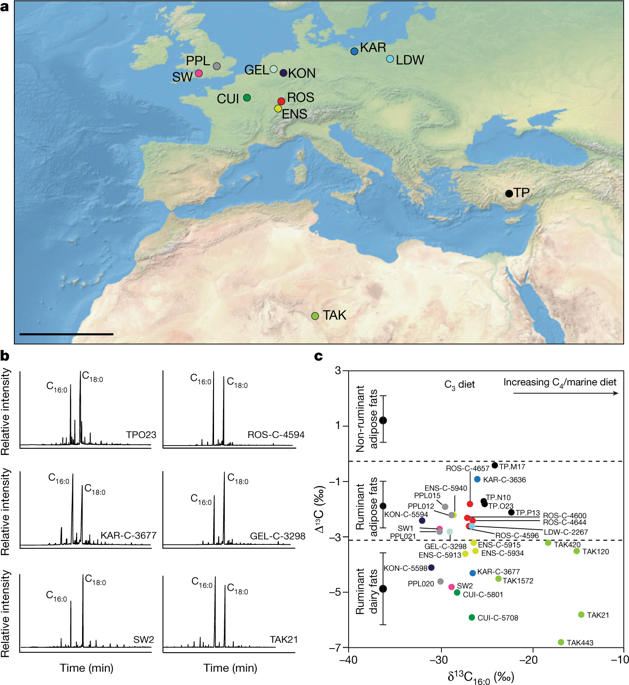Nature ( IF 50.5 ) Pub Date : 2020-04-08 , DOI: 10.1038/s41586-020-2178-z Emmanuelle Casanova 1 , Timothy D J Knowles 1, 2 , Alex Bayliss 3, 4 , Julie Dunne 1 , Marek Z Barański 5 , Anthony Denaire 6 , Philippe Lefranc 7 , Savino di Lernia 8, 9 , Mélanie Roffet-Salque 1 , Jessica Smyth 1, 10 , Alistair Barclay 11 , Toby Gillard 1 , Erich Claßen 12 , Bryony Coles 13 , Michael Ilett 14 , Christian Jeunesse 15 , Marta Krueger 16 , Arkadiusz Marciniak 16 , Steve Minnitt 17 , Rocco Rotunno 8 , Pieter van de Velde 18 , Ivo van Wijk 19 , Jonathan Cotton 20 , Andy Daykin 20 , Richard P Evershed 1, 2

|
Pottery is one of the most commonly recovered artefacts from archaeological sites. Despite more than a century of relative dating based on typology and seriation1, accurate dating of pottery using the radiocarbon dating method has proven extremely challenging owing to the limited survival of organic temper and unreliability of visible residues2,3,4. Here we report a method to directly date archaeological pottery based on accelerator mass spectrometry analysis of 14C in absorbed food residues using palmitic (C16:0) and stearic (C18:0) fatty acids purified by preparative gas chromatography5,6,7,8. We present accurate compound-specific radiocarbon determinations of lipids extracted from pottery vessels, which were rigorously evaluated by comparison with dendrochronological dates9,10 and inclusion in site and regional chronologies that contained previously determined radiocarbon dates on other materials11,12,13,14,15. Notably, the compound-specific dates from each of the C16:0 and C18:0 fatty acids in pottery vessels provide an internal quality control of the results6 and are entirely compatible with dates for other commonly dated materials. Accurate radiocarbon dating of pottery vessels can reveal: (1) the period of use of pottery; (2) the antiquity of organic residues, including when specific foodstuffs were exploited; (3) the chronology of sites in the absence of traditionally datable materials; and (4) direct verification of pottery typochronologies. Here we used the method to date the exploitation of dairy and carcass products in Neolithic vessels from Britain, Anatolia, central and western Europe, and Saharan Africa.
中文翻译:

考古陶器的准确化合物特异性 14C 测年
陶器是考古遗址中最常见的出土文物之一。尽管基于类型学和系列1进行了一个多世纪的相对测年,但由于有机质的存活有限和可见残留物的不可靠性2,3,4 ,使用放射性碳测年方法对陶器进行准确测年已被证明极具挑战性。在这里,我们报告了一种直接确定考古陶器年代的方法,该方法基于使用制备气相色谱法纯化的棕榈酸 (C 16:0 ) 和硬脂酸 (C 18:0 ) 脂肪酸5,6对吸收的食物残渣中的14 C进行加速器质谱分析, 7,8. 我们提供了从陶器容器中提取的脂质的准确的化合物特异性放射性碳测定,通过与树木年代学日期9,10的比较以及包含在其他材料上先前确定的放射性碳日期11,12,13,14的地点和区域年表的比较,对其进行了严格评估,15 . 值得注意的是,陶瓷器皿中 C 16:0和 C 18:0脂肪酸中的每种脂肪酸的特定化合物日期提供了结果的内部质量控制6并且与其他常用日期材料的日期完全兼容。陶器的准确放射性碳测年可以揭示:(1)陶器的使用时期;(2) 有机残留物的年代久远,包括开发特定食品的时间;(3) 在没有传统可数据材料的情况下的站点年表;(4) 直接验证陶器类型年代学。在这里,我们使用该方法对来自英国、安纳托利亚、中欧和西欧以及撒哈拉非洲的新石器时代船只中乳制品和胴体产品的开采进行了测定。











































 京公网安备 11010802027423号
京公网安备 11010802027423号